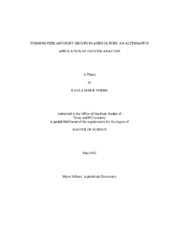| dc.description.abstract | A "peer advisory group" essentially melds a business advisory board with a peer group. Peer advisory groups consist of business managers who meet together for the purpose of mutual self-improvement and learning through the sharing of experiences. The entire peer advisory group concept encompasses many variations and this research focuses on groups consisting of farm managers.
Unfortunately, some farm managers who wish to participate have expressed frustration with group formation: they find it difficult to identify suitable individuals to participate in a peer advisory group with. Peer advisory groups can take many forms, and experts have suggested an individual should specifically seek out people interested in the same type of group. For example, an individual who wants to strictly focus discussion on production issues should seek out other individuals who also seek to focus on production discussions. Some individuals have suggested that some type of "clearinghouse" organizations could be beneficial in assisting individuals with the peer advisory group formation problem. Such an organization would likely need to adapt some sort of method for identifying individuals who have interest in a similar type of group.
Although this could be approached from several different angles, one possible approach involves the practice of cluster analysis?a wide set of procedures intended to break down a set of objects into "clusters" of individuals with similar attributes. Cluster analysis comes with several attractive benefits; however, literature includes countless variations in the methods and criticisms of certain aspects of the methodology. This thesis focuses on using cluster analysis to assist with peer advisory group formation. More specifically, this thesis seeks to answer the following question: how could a clearinghouse organization apply cluster analysis methods to a pool of candidates to effectively create peer advisory groups congruent to the individuals' needs and wants? An approach was proposed which differs slightly from traditional cluster analysis methods, and this was applied to a hypothetical pool of candidates, along with several control methods. The proposed approach was found to most effectively create peer advisory groups which fulfilled the desires of the individuals. | en |


